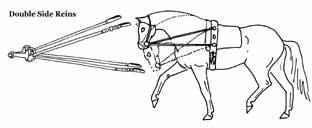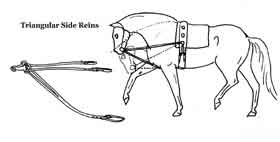|
The Art of Lungeing
Running Reins by Liz Tollarzo

An artifical aid that can be useful
for some lungeing situations. Running reins are simple devices for encouraging
lowering of the head and a more rounded outline.
In the pursuit to produce an obedient, supple horse that is a pleasure
to ride, many riders and trainers elect to use an artificial aid of some
type when lungeing - the aim of this being to encourage the head to lower
and the horse’s overall outline to become rounder. Not every lungeing
aid suits all horses so sometimes a little experimentation can be useful
to determine what best suits each individual.
Previous articles in this series have explained the use of single side
reins - the simplest aid available to assist with control of the horse’s
frame; the chambon - the only device that lets the horse stretch fully
forward, down and out; and the Pessoa - a training system that can assist
in activating the hindquarters whilst positioning the head and neck. Another
schooling aid that can be useful and worth experimenting with for the
more sensitive or difficult-mouthed horse is the running rein.
A running rein is actually a type of side rein however, as its name suggests,
it allows a horse to alter its head position more freely than single side
reins by ‘running’ through the bit rings rather than being fixed
to them. There are many ways a running rein can be attached, all producing
different effects on the horse’s carriage and way of going. Some,
such as the triangular running rein, can also be used when a horse is
being ridden rather than lunged.
Commercially available running reins are usually made of leather or webbing
and include types known as triangular side reins and double side reins.
It is also possible to contruct a homemade variety of running rein from
thin rope or cord.
Triangular Running Reins
Triangular side reins have an adjustable loop that attaches to the girth
of the lunge roller or saddle between the horse’s legs. As the strap
that starts with this loop continues up towards the bit, it branches into
two individual straps - similar to how a running martingale does. This
similarity to a martingale then ceases, as the individual running rein
straps pass through the bit rings (rather than being clipped or buckled
onto them) from the inside to the outside. Their ends are then buckled
to the side of the roller or onto the girth points of the saddle about
half way up the horse’s rib cage, in a similar position to that of
a single side rein.
The triangular arrangement of this type of running rein allows a little
‘up and down’ movement of the head due to the sliding of the
straps over the bit rings, however the attachment point between the horse’s
legs very clearly encourages the head to stay down. Unfortunately, it
is almost impossible for a horse to maintain a steady contact with this
device as the action of the front legs tends to ‘jiggle’ the
reins as every stride is taken - leading to a tendency to come behind
the contact to avoid these vibrations.
Double Side Reins
Often just referred to as ‘running reins’, double side reins
also allow a horse more freedom to change the height of its head position
than do single side reins. Consisting of two individual reins (one for
each side of the horse) with an adjustment for length at each end, this
style of running rein attaches to the side of the roller or girth points
of the saddle then passes through the bit rings - from inside to outside
- and buckles to the top of the roller or saddle near the wither area.
Due to there not being an attachment point between the horse’s legs,
this device allows a steadier contact through the reins to the mouth than
does the triangular side reins. The slight amount of ‘play’
allowed by double side reins, however, makes them more readily acceptable
to a sensitive horse, or one that is reluctant to take up the contact
when a single side rein is used.
If desired, the end of each double rein that would normally be attached
to the side of the roller or saddle can be fastened down between the horse’s
legs - in a similar fashion to triangular side reins. This then alters
their action on the mouth and encourages more downward movement of the
head.
Homemade Options
Many homemade mouthing arrangements make use of a ‘running rein’
constructed from rope, with clips then being tied or spliced to the ends
for easy attachment. Many horse breakers favour a roller with a pulley
up on the wither - attaching a single piece of rope to the girth (either
between the front legs or at the side above the horse’s elbows) then
running it through the bit rings up to the pulley, repeating this on the
other side.
A running rein that consists of only one length allows the horse to moves
its head from side to side, as well as up and down. This can be of great
assistance to a breaker in educating the mouth to give to pressure, whilst
the bend it also allows can make this lesson a lot clearer for the young
horse and is less likely to cause panic than if a fixed rein were to be
used. Horses can be lunged freely and even be long reined in this sort
of rein attachment. A stiff horse, however, that does not readily bend
to the inside whilst lungeing will not benefit from this type of running
rein, as it will allow too much freedom of the neck to the side as the
horse avoids correctly bending on the circle line.
Precautions
It is important to remember that no running rein (or side rein) will allow
the nose of the horse to come forward, down and out, as only the chambon
produces this head and neck position. Their primary role is to encourage
the head to lower, so they can be used as an initial ‘stepping stone’
to a more rounded frame but other devices are more suited to encouraging
the forward stretching of the neck and impulsion from the hindquarters
needed for more advanced work.
As with any artificial aid, running reins must be introduced slowly by
being fitted loosely at first and gradually shortened only after the horse
accepts them. Free time at walk with the reins or devices unfastened should
be allowed during the lungeing period for relaxation of muscles that have
been working hard. The length of the reins of any lungeing aid should
also be regularly altered to avoid the situation of a horse working in
any one frame for too long. Most horses will also need the length of the
rein to be adjusted for working at different paces, especially at the
walk where a rein that is too tight can cause serious evasions and resistances.
As with riding, the equipment on the horse ready for lungeing should always
be kept as simple as possible, but there is no single device that can
guarantee an improvement in the way of going of every horse. Yet, by studying
work on the lunge in terms of each horse’s behaviour and response
to various artificial aids, it should be possible for the trainer to decide
whether a piece of equipment is actually benefiting the horse’s education,
physical development and mental well-being.
The next article in this series will focus on
long reining, also known as double-rein lungeing. The complete series
of lungeing articles include Vol 27-1, The Art Of Lungeing; Vol 27-2,
Learning To Lunge; Vol 27-3, Troubleshooting; Vol 27-4, Side Reins; Vol
27-5, Bending and Lightening on The Lunge; Vol 27-6, Lungeing Transitions;
Vol 28-1, Running Reins. These are available as back copies - details
are on the www.hoofbeats.com.au website, under Previous issues, then click
Back Copies. .
|